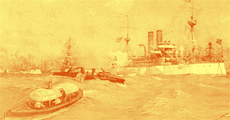

Indigenous Resistance
The
unjust execution of the three Filipino priests Mariano Gomez,
Jose Burgos,
and Jacinto Zamora in 1872 was a turning point in Philippine history for it ushered in a new era -
the reform movement. Several secret societies were formed to act against the Spanish rule in 1892.
The foremost of these were the Philippine League founded by
Dr. Jose Rizal in 1891.
The failure of the reform movement, in another sense, however led to the founding of the revolutionary
Katipunan ("association") founded by
Andres Bonifacio
with separatist aims; to secure the independence and freedom of the Philippines by force of arms against Spain.
The existence of the Katipunan was disclosed to Spanish officials on August 19, 1896, and on August 26,
the insurrectionists, no longer able to hide their activity, began armed hostilities.
Under the leadership
 of Gen. Emilio Aguinaldo,
chief of the rebel forces, the insurgents were initially successful.
Reinforcements from Spain, however, substantially weakened the rebellion in early 1897,
and in August of that year Aguinaldo and the Spanish governor-general signed the Pact of Biak-na-bato,
guaranteeing Spanish reforms within three years. The pact was conditional upon the withdrawal of the Filipino leaders from
the islands, and Aguinaldo went to Hong Kong with his associates, but domestic events were soon overshadowed
by the beginning of the Spanish-American War on April 21, 1898. On May 1 the Asian squadron of the U.S.
Navy destroyed the Spanish fleet in Manila Bay.
of Gen. Emilio Aguinaldo,
chief of the rebel forces, the insurgents were initially successful.
Reinforcements from Spain, however, substantially weakened the rebellion in early 1897,
and in August of that year Aguinaldo and the Spanish governor-general signed the Pact of Biak-na-bato,
guaranteeing Spanish reforms within three years. The pact was conditional upon the withdrawal of the Filipino leaders from
the islands, and Aguinaldo went to Hong Kong with his associates, but domestic events were soon overshadowed
by the beginning of the Spanish-American War on April 21, 1898. On May 1 the Asian squadron of the U.S.
Navy destroyed the Spanish fleet in Manila Bay.
U.S. Rule
With U.S. help,
Aguinaldo returned to the islands on May 19 and proclaimed an independent Philippine republic.
By the terms of the Treaty of Paris (December 10, 1898), however, Spain ceded the entire
archipelago to the United States in return for $20 million, and on December 21 the U.S.
proclaimed the establishment of U.S. military rule. Aguinaldo and his associates refused to
acknowledge U.S. domination. A provisional Filipino government was established at Malolos,
in central Luzon, on January 23, 1899. Tension increased, and on February 4, hostilities began at Manila,
when a Filipino patrol provoked the fire of a U.S. sentry. The insurgents were driven back almost at once by
U.S. troops, and in November 1899, the Filipinos resorted to guerilla warfare. Aguinaldo was captured on March 23, 1901, and he swore an oath of allegiance to the United
States in April, but sporadic warfare continued for still another year.
At the end of
the insurrection in 1902 U.S. civil government replaced the military authority, and on July 4, 1902,
William Howard Taft, later president of the United States, became the first civil governor. The Philippine
Bill of 1902 provided for the establishment of a bicameral legislature, and five years later, on October 16, 1907,
the first session of the Philippine assembly opened, with an elected lower house and the Philippine Commission,
previously established, as the upper house.
